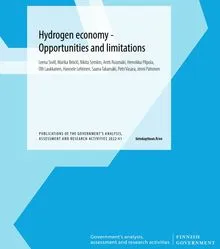Finland publishes hydrogen economy roadmap
Finland needs political decisions on the goals of the development of a Finnish hydrogen economy and the measures to be taken to reach those goals.

The hydrogen economy aims to reduce CO2 emissions in sectors and processes where utilising other solutions is particularly challenging. Such processes can be found in industries, aviation, maritime transport, and heavy-duty road transport.
The hydrogen economy provides an opportunity for Finland, as Finnish power generation has a relatively low carbon intensity and there is a stable national transmission grid for electricity available. Furthermore, Finland has vast potential for additional wind power, which could be utilised to produce hydrogen and electrofuels to meet domestic demand as well as for exports. On the other hand, the future supply and demand still remain highly uncertain in the international market. Strong competition is anticipated between different technologies and alternative locations for production.
Finland must ensure preconditions for industrial investments in the hydrogen economy and create clear targets and an action plan for the hydrogen transition in different sectors. The development of the hydrogen economy can be supported, e.g., by easing the licensing of additional wind power construction, increasing hydrogen expertise, and supporting R&D activities in technologies, services, and collaboration. Electricity and hydrogen transmission infrastructures should be developed as a whole in preparation for future needs while managing the related risks and costs. Alternative technologies and solutions must be considered along with the hydrogen-based solutions. In addition, conditions for fair competition must be ensured both domestically and internationally.
In 2020, Finland produced an estimated 145,000 tonnes of hydrogen (5 TWh) for industrial needs, which accounts for approximately 1.5 per cent of all hydrogen produced in Europe. In addition, hydrogen is also generated as a by-product in industrial processes. Twenty three thousand tonnes (765 GWh) of such hydrogen were generated 2020, but statistics are incomplete in this respect. The most significant applications of hydrogen in Finnish industry are oil refinement and production of biofuels.
The five hydrogen scenarios created for Finland describe alternative futures for Finnish industry, Finnish and international transport and heavy transport and the export of hydrogen and e-fuels.
In the scenarios, the production volumes of clean hydrogen vary between 3.7–7.9 TWh in 2030 and reach up to 6.4–132.9 TWh by 2050. The large differences are caused by assumptions made on the export of hydrogen and e-fuels: the minimum scenarios concentrate on domestic demand while the maximum scenarios also consider the export of hydrogen and/or e-fuels.
In the maximum scenarios, the required electrolyser capacity would reach up to 27 GW by 2050 and the required extra capacity of wind power to 53 GW (cf. 3.3 GW in 2021) with the required cumulative investments at slightly less than EUR 90 billion. Reaching the maximum scenarios would require that Finland remain extremely competitive in the international market and at the same time the international demand corresponds to or exceeds the energy scenarios presented by the European Commission.
In the minimum scenarios, the required electrolyser capacity would be between 0.5–1.3 GW by 2030 and would stay at that level in the smallest of the minimum scenarios. In the other minimum scenario, the capacity would rise to 2.6 GW by 2050. The necessary increase in wind power would be 1.1– 5.2 GW and the investment costs would remain below EUR 6.2 billion.